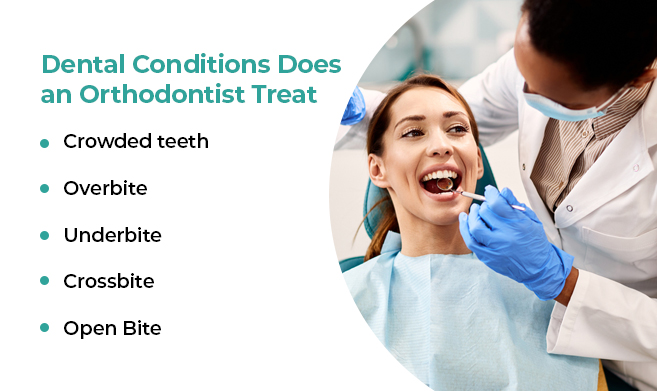More About Legacy Orthodontics
More About Legacy Orthodontics
Blog Article
Some Known Details About Legacy Orthodontics
Table of ContentsLegacy Orthodontics - Questions8 Simple Techniques For Legacy OrthodonticsThe Single Strategy To Use For Legacy OrthodonticsAbout Legacy OrthodonticsThe Legacy Orthodontics Statements
In addition, we offer flexible therapy routines, versatile repayment options and a fun, satisfying experience.An orthodontist is a dental professional educated to diagnose, protect against, and deal with teeth and jaw abnormalities. Orthodontists function with individuals of all ages, from youngsters to grownups.
Malocclusion, or misaligned teeth, can bring about oral issues, consisting of dental caries, gum illness, and hard or painful chewing. Yet not everybody is born with straight teeth. If you have a poor bite or huge spaces in between your teeth, you might intend to consult a dentist focusing on orthodontic care.
Unknown Facts About Legacy Orthodontics
( Photo Credit Rating: DigitalVision/Getty Images) Orthodontists utilize repaired and removable dental tools, like braces, retainers, and bands, to transform the setting of teeth in your mouth. Orthodontic therapy is for oral irregularities, including: Uneven teethBite issues, like an overbite or an underbiteCrowded teeth or teeth that are as well far apartJaw misalignmentThe goal of orthodontic treatment is to boost your bite.
A healthy and balanced bite guarantees you can consume, eat, and talk effectively. While you might think about orthodontists as generally for youngsters or teenagers who need braces, they can remedy dental troubles at any type of age. Orthodontists attend university, oral school, and orthodontic school. After college graduation, they spend 2 or 3 years in an orthodontic residency program.
All orthodontists are dentists, yet not all dental practitioners are orthodontists. Orthodontic residency programs offer extensive, focused instruction for dental professionals. They concentrate on two locations: Just how to appropriately and safely relocate teeth Exactly how to correctly guide growth in the teeth, jaw, and faceOnce an orthodontist has completed training, they have the option to come to be board certified.
Legacy Orthodontics for Beginners
Imbalance, or malocclusion, is one of the most usual factor people see an orthodontist. It is hereditary and is the outcome of dimension differences between the top and reduced jaw or between the jaw and teeth. Malocclusion leads to tooth congestion, a twisted jaw, or uneven bite patterns. Malocclusion is generally treated with: Your orthodontist affixes steel, ceramic, or plastic square bonds to your teeth.
If you have only small malocclusion, you might have the ability to make use of clear dental braces, called aligners, rather than typical braces (https://www.storeboard.com/legacyorthodontics1). Some individuals require a headwear to aid relocate teeth into line with pressure from outside the mouth. After braces or aligners, you'll require to put on a retainer. A retainer is a customized gadget that keeps your teeth in location.
They can produce added space in the mouth without having to pull teeth. Orthodontists utilize cords, surgical screws, or plates to support your jaw bone.
You may require to see an orthodontist if you have: Crowding or otherwise sufficient area for all of your teethOverbite, when your top teeth come by your base teethUnderbite, when your base teeth are too far forwardSpacing or issues with gapsCrossbite, which is when your top teeth fit behind your base teeth when your mouth is closedOpen bite or a vertical void in between your front base and upper teethMisplaced midline, when the center of your base and upper teeth do not line up Remedying a dental visit site malocclusion can: Make attacking, chewing, and speaking easierImprove the balance of our face and your total appearanceEase discomfort from temporomandibular joint problemsDifferent your teeth and make them easier to clean, aiding prevent dental caries or tooth cavities It's commonly a dental practitioner that initially notices misaligned teeth throughout a routine exam.
Little Known Questions About Legacy Orthodontics.

During your first orthodontic appointment, you'll likely have: An oral examPhotos taken of your face and smileDental X-raysPanoramic (360 degree) X-rays of your face and headImpressions to create molds of your teethThese tests will certainly aid your orthodontist recognize how to continue with your therapy. orthodontics. An orthodontist is a dental professional who's had training to treat your teeth and jaw
Orthodontists may do surgical treatment, exams,X-rays,and more to aid you acquire a more comfortable, much healthier smile. An orthodontist is concentrated on your bite, so something like a broken tooth would be taken care of by a dental professional. Orthodontists are dental practitioners but not all dentists are orthodontists. Orthodontists are concentrated on your bite, or the means your teeth meshed, and the straightness of your teeth.
Ever before wondered how stars always appear to have completely aligned teeth? The solution usually depends on the competent hands of an orthodontist. However exactly what does an orthodontist do? Orthodontists are oral experts that focus on remedying irregularities in the teeth and jaws. Their knowledge goes past just creating a stunning smile; it encompasses boosting your general dental health and function.
Legacy Orthodontics Fundamentals Explained

While dental braces are one of the most typically identified orthodontic treatment, orthodontists have a varied toolkit at their disposal. The specific strategy chosen relies on the extent of the instance, the patient's age, and private preferences. These tried-and-true dental braces use a system of brackets bound to the teeth and linked by cables.
Clear aligners, like Invisalign, are a prominent option for people looking for a more discreet therapy option. These removable trays are customized to gradually move the teeth's setting. Headwear might be utilized combined with braces or aligners to apply added targeted pressures, specifically for dealing with jaw disparities. In cases of narrow jaws, palatal expanders can be made use of to produce area for proper tooth placement.
Report this page